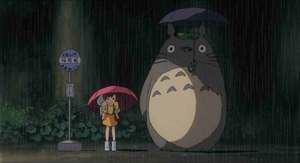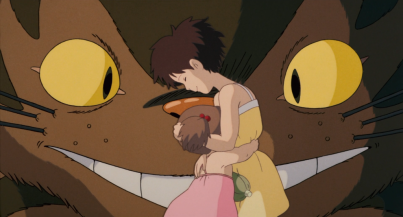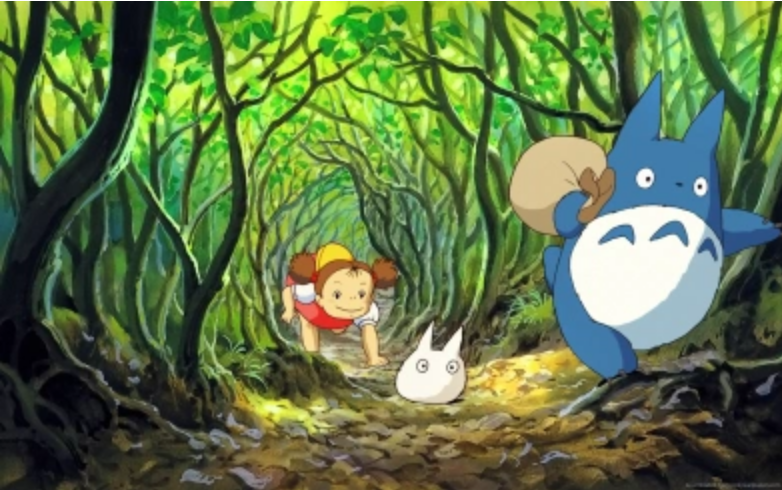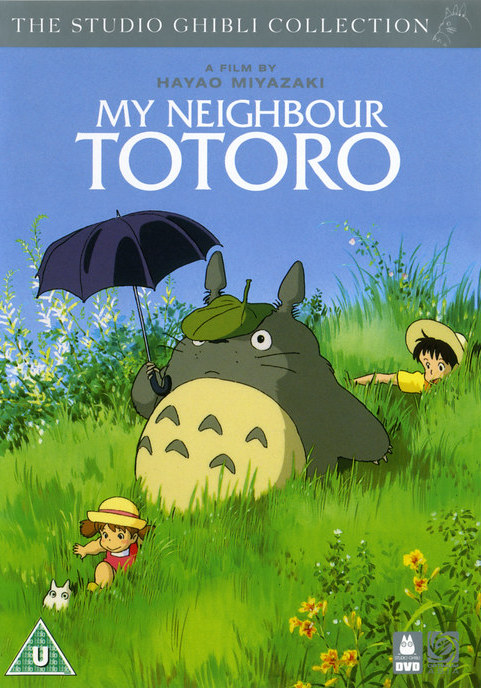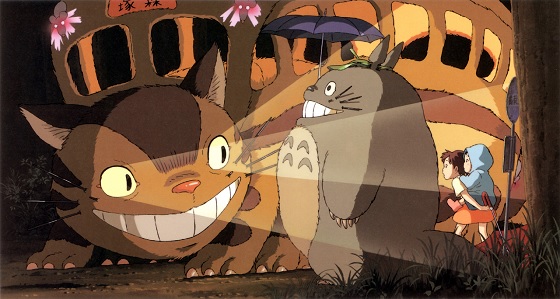My Neighbour Totoro is a Japanese animation film produced by Studio Ghibli and directed by Hayao Miyazaki. It was released in 1988 and helped bring fame and recognition to Studio Ghibli as a viable film production company. The film begins with Kusakabe Tatsuo and his daughters Satsuki and Mei moving to the countryside in order to be closer to the hospital in which their ill mother is staying. The house is unusual; it is already inhabited by dust sprites (susuwatan) that seemingly magically appear and disappear. The younger of the two sisters, Mei, comes across a small semi-invisible creature in the grass outside their house and is lead to a giant snoring creature inside the camphor tree. This creature is Totoro, a cat – or bear – like spirit animal of the forest who apparently presides over nature and has almost supernatural powers. The sisters both form an unspoken relationship with Totoro and although he is not visible to the adults in the film, they believe the girls’ accounts.
The animals in the film, namely the spirit animal Totoro and the cat bus enable the narrative to uphold a childlike fantasy plot, without however making the film childish. [1] The elements in the film are, I think, too complex to be deemed ones of that of a children’s film. My Neighbour Totoro differs from a typical Western animation as there is no clear hero versus villain set-up and the audience is not encouraged to like any one character over another. Slapstick comedy elements do not exist in the film, instead, character development is focused upon, rather than an idealistic love or good over evil story. Important ideas such as ‘how respect for the environment can lead to harmony and reward’ [2] and children as a ‘liberating force that allows anything to be possible’ [3] frame the girls’ development in the film from dependent children to young, reasoning grownups who are able to consider and deal with problems that are very much a part of the adult world.
The first animal presence in the film is that of the dust sprites that initially ‘haunt’ the house. Mei, the younger sister, chases them through the house and is the one most intrigued by them. They set the scene for a fantasy film and spark the audience’s interest of what other magical elements there will be in the film. It is also interesting that the first creature in the film is one of such a small size and that Totoro is quite large. The increase in size of the creatures is representative of a build-up in the amount of magic and imagination in the film, and of the girls’ capacity to deal with the difficult situation they are in, which seems to perpetually worsen. The dust sprites also conveniently encourage the audience to trust Mei and Satsuki as morally ‘good’ characters as Granny tells the girls that if the dust sprites think they are ‘good’ people, they will leave them alone in the house. As the sprites do indeed leave, we as an audience can trust their moral judgement (as the only one that has thus far been brought about) and therefore also believe the girls to be inherently good. After the dust sprites we see another creature on screen. It is a small, semi-transparent, white rabbit-like animal, that Mei spots in the grass outside their house while she is playing, waiting for Satsuki to come home from school. We are instantly directed to recognise Mei as a young child in the preceding scenes- she asks her father to play a game as a make believe flower shop owner, then she completely gives herself over to chasing the animal in the outside space. This is important to note as we realise further in the film that adults are unable to see these creatures although they do take the girls’ claims seriously and do not discourage their aptitude for perceiving the fantastical. She follows it until it disappears under the house and sneaks past her with a small totoro and then she continues to chase them towards the forest and into a small hidden gap in the surrounding bushes. The two spirit creatures lead Mei to a huge camphor tree and inside, in complete peace with the setting, surrounded by the sheer beauty of nature is a giant cat-like creature, a huge totoro. It does not flinch at Mei’s presence, rather once it sees she is peaceful too it goes back to sleep and allows her to sleep on his chest. This is significant because it shows an instant affinity with nature, something that apparently is mostly accessible to children and suggests that by acting respectfully you will gain respect in return. This is emphasised shortly afterwards in the film by Mei’s father as he goes with her and Satsuki to pay reverence to the camphor tree and to thank the forest for protecting their family.
Later in the film Satsuki and Mei go to wait for their father at the bus stop after work as he has forgotten his umbrella and it is pouring with rain. Here, a frog hops across the road and before the arrival of any other animals, pathetic fallacy is implemented as the rain pours down heavier without ceasing as the girls’ moods worsen as they wait for their father. Totoro arrives at the bus stop next to them, and Satsuki although in the adult role (she is carrying Mei and it was her who decided to go to the bus stop) sees him and offers him an umbrella to take the place of his leaf. Here, Totoro acts as a relief from the desperate situation of the girls and brings them some amusement or escapism from their current situation. He jumps up and down to force the rain drops off of the leaves onto his umbrella as he appears to like the sound they make above his head. This childlike delight is something Satsuki and Mei can share in and it helps them to act like children despite the fact that they are often required to act in a manner more mature than their years. A huge ‘cat bus’ arrives at the stop to pick Totoro up, it is reminiscent of the grinning Cheshire Cat from Alice in Wonderland though there is something more science fiction-esque about it as the noise that is made when its side turns into a door for Totoro to enter echoes that of what we would recognise as being made by a spaceship. The cat bus adds to Totoro’s comic relief of the downbeat scene as well as an intrigue as to whether or not it will appear again.
I think the most important scene with regards to the film’s message of respecting nature is when Satsuki and Mei are waiting for their acorns to grow- with little success. Totoro appears to draw the seedlings up into shoots and then to trees with strokes of his arms upwards towards to the sky. This action is mimicked by the girls and throughout the dreamlike sequence they are euphoric, again being enabled to behave as children taking delight in their surroundings- the wide open green space around them and the growth of the new trees. Stylistically this is a joy to watch as the trees mirror the girls movements, manifesting their joy as large trees sprouting from the earth. During this sequence the music is uplifting and positive, with a playful upbeat undertone which suits the sheer happiness surging through all the characters on scene. This importance of respecting nature, your surroundings and living harmoniously with the environment are clear focusses of the film and are exemplified perfectly with this scene as the following morning although the acorns have not grown to full height they have at least begun to sprout. This could either be down to the girls’ patience and treatment of the environment or through a kind of magical aid given by Totoro. The girls develop and mature throughout the film, Satsuki continues to act in a manner often beyond her years and takes the ‘mother’ role out of the two of them and Mei learns to be more self-reliant and that running away will not solve her problems. With regards to animal representation within this animation film Totoro acts as a vehicle for the girls’ development and facilitates their need for escapism, perhaps even acting as a means for coping with their unfortunate situation. I think this is particularly pertinent when Mei goes missing and Satsuki cannot find her despite running quite a distance from their house. Totoro summons the cat bus for her and then upon searching even farther away the sisters are reunited. The cat bus is rendered as a hopeful image on screen as it is brightly coloured and bounds across the landscape. Its actions and its aesthetic are representative of its ability to find Mei as it is a positive, uplifting image in a desperate situation. The cat bus takes them to their mother’s hospital so that they can see she is not as unwell as they had imagined but they remain hidden in a tree. Satsuki and Mei’s mother thinks that she sees something from her window- Satsuki and Mei’s faces smiling down at her from the tree- but she cannot be certain. It is interesting to note here that Miyazaki allows the childlike world of Totoro and the adult human world to merge as previously adults have not been able to share in Satsuki and Mei’s adventures. This merging of the two worlds is extremely important as it indicates that Totoro and the fantasy world have been the catalyst in enabling Satsuki and Mei to develop from innocent children to responsible young people. Their continual respect for nature is rewarded by Totoro and the cat bus, who offer them aid in their most desperate hour. As the girls move from their child realm into a more complex one, the cat bus is briefly brought with them, being partly the source of their transition at the same as reminding the girls’ mother that they have often lived in a dream world as children.
My Neighbour Totoro is arguably different to many other animation films I have seen as although there is a childlike element I do not think it is childish- the issues presented in the film are ones that transcend those of a typical love or good vs evil story. Furthermore, animation films often use animals as they have even more freedom over movement and potential for the fantastical but despite Miyazaki’s use of animals in My Neighbour Totoro I do not think the focus is on the absurd or on comical elements that you may for example see in films such as Ice Age, Kung Fu Panda and Madagascar. The human-animal encounters also differ as there is no sense of power of one over the other in the film; neither is presented as having more worth in society or being more important. A key film to compare with My Neighbour Totoro is Princess Mononoke, another Studio Ghibli film that presents a difficult argument between who is ‘right’ and who is ‘wrong’ with relation to humans and animals, and who should have ultimate decision over a given situation, despite the potential of it damaging one party. Miyazaki not only presents complex issues via animation films that are easily consumed by children but ultimately uses the genre to appeal to a wide audience and breaks the bounds of human and animal actors while incorporating Japanese history and culture to make a rich, complex film.
[1] Colin Odell and Michelle Le Blanc, Studio Ghibli (Harpenden, Herts: Kamera, 2009), p. 81.
[2] Colin Odell and Michelle Le Blanc, Studio Ghibli (Harpenden, Herts: Kamera, 2009), p. 20.
[3] Colin Odell and Michelle Le Blanc, Studio Ghibli (Harpenden, Herts: Kamera, 2009), p. 23.
